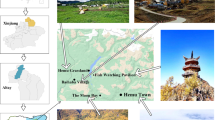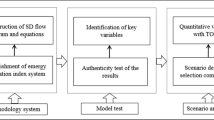Abstract
This paper outlines a method for determining carrying capacity for economic investments based on an emergy evaluation of the environmental resources of a region. Using data from tourism development in Mexico and Papua New Guinea, the concept of carrying capacity is related to intensity of development, environmental support area, and the “fit” of economic development in local environments and economies.
Emergy, a unit of resource use and work potential, is used to quantitatively evaluate intensity of development. Emergy evaluation is briefly described and the evaluations of tourism used to further explain the methodology. The total annual resource use for the tourist resorts and the economies in which they are embedded (including inputs of renewable and nonrenewable resources and purchased goods and services) was calculated and converted to emergy units. The renewable resource base and an Environmental Loading Ratio (ELR), are proposed as a means for determining both long term and short term carrying capacity respectively. The concept of sustainable development is related to the net emergy benefits that result from development. Expressed as a ratio of the amount of emergy received by the local economy to the amount that is exported (embodied in tourists), sustainability is suggested to result from a positive emergy trade balance.
Similar content being viewed by others
REFERENCES
Arrow, K., Bolin, B., Costanza, R., Dasgupta, P., Folke, C., Holling, C. S., Jansson, B. O., Levin, S., Maeler, K. G., Perrings, C., & Dimentel, D. (1995). Economic growth, carrying capacity, and the environment. Science 268 (5210), 520–521.
Brown, M. T. (1980). Energy Basis for Hierarchies in Urban and Regional Landscapes. PhD Dissertation. Gainesville: University of Florida.
Brown, M. T., Gonzales, A., Green, P., & Venegas, J. (1992). Energy Analysis Perspectives, Public Policy Options, and Development Guidelines for the Coastal Zone of Nayarit, Mexico. Final Report to the Cousteau Society. Gainesville: Center for Wetlands, University of Florida.
Brown, M. T., & McClanahan, T. (1996). Emergy Analysis Perspectives for Thailand and Mekong River Dam Proposals. Ecological Modeling 91,105–130.
Brown, M. T., Odum, H. T., Murphy, R. C., Christianson, R. A., Doherty, S. J., McClanahan, T. R., & Tennenbaum, S. E. (1995). Rediscovery of the World: Developing an Interface of Ecology and Economics. In C.A.S. Hall (Ed.), Maximum Power: The Ideas and Applications of H. T. Odum, pp. 216–250. Boulder: University of Colorado Press.
Brown, M. T., Tennenbaum, S., & Odum, H. T. (1990). Emergy Analysis and Public Policy Perspectives of the Sea of Cortez, Mexico. Final Report to The Cousteau Society. Gainesville: Center for Wetlands, University of Florida.
Brown, M. T., & Ulgiati, S. (1997). Emergy Based Indices and Ratios to Evaluate Sustainability: Monitoring technology and economies toward environmentally sound innovation. Ecological Engineering 9, 51–69.
Campbell, D. E. (1998). Emergy analysis of human carrying capacity and regional sustainability: An example using the State of Maine. Environmental Monitoring and Assessment 51, 531–569.
Carey, D. I. (1993). Development based on carrying capacity: A strategy for environmental protection. Global Environmental Change 3(2), 140–148.
Cohen, J. E. (1995). Population growth and Earth's human carrying capacity. Science 26(5222), 341–346.
Cohen, J. E. (1997). Population, economics, environment and culture: An introduction to human carrying capacity. Journal of Applied Ecology 34(6), 1325–1333.
Doherty, S. J., & Brown, M. T. (1993). Emergy Analysis Perspectives, Sustainable Development, and Public Policy Options for Papua New Guinea. Final Report to Cousteau Society. Gainesville: Center for Wetlands, University of Florida.
Fearnside, P. M. (1997). Human carrying capacity estimation in Brazilian Amazonia as a basis for sustainable development. Environmental Conservation 24(3), 271–282.
Folke, C., Jansson, A., Larsson, J., & Costanza, R. (1997). Ambio 26(3), 167–172.
Harris, J. M., & Kennedy, S. (1999). Carrying capacity in agriculture: Global and regional issues. Ecological Economics 29, 443–461.
King, J., & Slesser, M. (1995). Prospects for sustainable development: The significance of population growth. Population and Environment 16(6), 487–505.
McConnell, R. L. (1995). The human population carrying capacity of the Chesapeake Bay Watershed: A preliminary analysis. Population and Environment 16(4), 339–352.
Odum, H. T. (1980). Principle of Environmental Energy Matching for Estimating Potential Economic Value: A Rebuttal. Coastal Zone Management 5(3), 239–243.
Odum, H. T. (1983). Systems Ecology: An Introduction. New York: John Wiley.
Odum, H. T. (1984). Embodied Energy, Foreign Trade, and Welfare of Nations. In A. M. Jansson (Ed.), Integration of Economy and Ecology: An Outlook for the Eighties, pp. 185–199. Proceedings of the Wallenberg Symposium. Stockholm, Sweden: Asko Laboratory.
Odum, H. T. (1988). Self-Organization, Transformity, and Information. Science 242, 1132–1139.
Odum, H. T. (1996). Environmental Accounting: Emergy and Environmental Decision Making. New York: John Wiley.
Odum, H. T., Brown, M. T., & Christianson, R. A. (1986a). Energy Systems Overview of the Amazon Basin. Report to the Cousteau Society. Gainesville: Center for Wetlands, University of Forida.
Sterrer, W. (1993). Human economics: A non-human perspective. Ecological Economics 7(3), 183–202.
Ulgiati, S., & Brown, M. T. (1998). Monitoring patterns of sustainability in natural and manmade ecosystems. Ecological Modeling 108(1–3), 1 May 1998.
Ulgiati, S., Brown, M. T., Bastianoni, S., & Marchettini, N. (1996). Emergy Based Indices and Ratios to Evaluate Sustainable Use of Resources. Ecological Engineering 5, 497–517.
Ulgiati, S., Odum, H. T., & Bastianoni, S. (1994). Emergy Use, Environmental Loading and Sustainability. An Emergy Analysis of Italy. Ecological Modeling 73, 215–268.
Van Den Bergh, J. C. J. M. (1993). A framework for modeling economy-environment-development relationships based on dynamic carrying capacity and sustainable development feedback. Environmental Resources and Economics 3(4), 395–412.
Wakernagle, M., & Rees W. E. (1995). Our Ecological Footprint: Reducing Human Impact on Earth. Gabriola Island, BC and Philadelphia, PA: New Society Publishers.
Wang, F., Odum, H. T., & Kangas, P. (1980). Energy Analysis for Environmental Impact Assessment. Journal of Water Resources, Planning and Management Division, July, 451–466.
Wetzel, K. R., & Wetzel, J. F. (1995). Sizing the earth: Recognition of economic carrying capacity. Ecological Economics 12(1), 13–21.
Author information
Authors and Affiliations
Rights and permissions
About this article
Cite this article
Brown, M.T., Ulgiati, S. Emergy Measures of Carrying Capacity to Evaluate Economic Investments. Population and Environment 22, 471–501 (2001). https://doi.org/10.1023/A:1010756704612
Issue Date:
DOI: https://doi.org/10.1023/A:1010756704612




